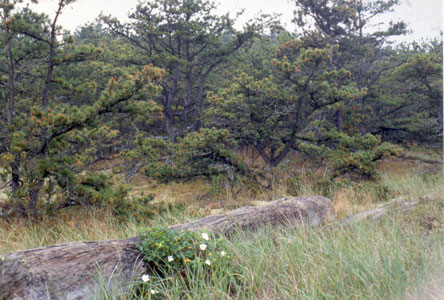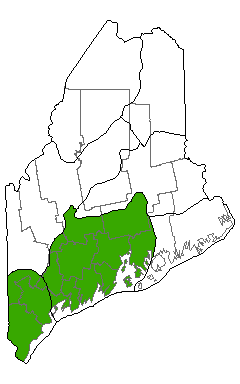DACF Home → Bureaus & Programs → Maine Natural Areas Program → Communities, Plants, and Animals → Natural Community Fact Sheets → Pitch Pine Dune Woodland
Printer Friendly Fact Sheet - 450 KB pdf (Get a free copy of Adobe Acrobat Reader)
Pitch Pine Dune Woodland
Scientific Name: Pitch Pine Dune Woodland; State Rank: S1

- Community Description
- Soil and Site Characteristics
- Diagnostics
- Similar Types
- Conservation, Wildlife and Management Considerations
- Distribution
- Characteristic Plants
- Associated Rare Plants
- Associated Rare Animals
- Examples on Conservation Lands You Can Visit
Community Description: These partial canopy woodlands (typically ~35% closure) support stunted pitch pine trees on sand dunes, where the density of the pines and the composition of the understory vary within and between sites. Bayberry, wild raisin, and/or alder form a patchy shrub layer. The herb layer is typically well developed (>35%), often with extensive patches of grasses or sedges. These are frequently disturbed forests on more dynamic dunes and may have patches of lichens and beach heather beneath the spotty canopy. Older examples on more stable dunes can be nearly closed canopy forests in which pitch pine is mixed with other species such as red maple, red oak, and paper birch, with less understory vegetation. Back to top.
Soil and Site Characteristics: Sites occur on open coastal dunes. The sandy substrate of this community is very dry, acidic, and nutrient poor, resulting in stunted tree growth. Only limited herbaceous species are able to tolerate the oceanside conditions. Back to top.
Diagnostics: These woodlands are distinguished by stunted pitch pine growing on stabilized dunes along the immediate coast. Back to top.
Similar Types: Pitch Pine - Scrub Oak Barrens and Pitch Pine - Heath Barrens are also partially forested with pitch pine, but occur more inland and have a well-developed shrub layer of scrub oak and/or ericaceous shrubs. Pitch Pine Woodlands occur on a bedrock substrate. Back to top.
Conservation, Wildlife and Management Considerations: This community appears to have been reduced in extent due to extensive beachfront development. Some of the remaining sites are ecologically intact, and while dynamic, are moderately well buffered from human impacts. They may, however, be vulnerable to ATV traffic, intensive recreational use, or over the longer term, sea level rise and severe storms. Most known sites are on public land or private conservation land.
Birds such as the pine warbler and prairie warbler may prefer this open habitat. This community type may include rare moths that utilize hard pines as larval host plants such as the pine pinion, oblique zale, and southern pine sphinx, which use pitch pine as a host plant. The pine-devil moth, a historical species for Maine, probably also inhabited this community type, where its larvae fed on pitch pine. Back to top.
Distribution: South-coastal Maine (Eastern Broadleaf Forest Province), extending south along the Atlantic coastal plain. This type achieves its greatest extent on Cape Cod. Landscape Pattern: Small Patch, typically less than 50 acres. Back to top.


Characteristic Plants: These plants are frequently found in this community type. Those with an asterisk are often diagnostic of this community.
- Canopy
- Pitch pine*
- Sapling/shrub
- Bayberry
- Speckled alder
- Wild-raisin
- Dwarf Shrub
- Beach heather*
- Golden heather*
- Lowbush blueberry
- Sheep laurel*
- Herb
- Canada mayflower
- Common hairgrass*
- Indian pipe
- Starflower*
- Wild sarsaparilla
- Woodland sedge
- Bryoid
- Reindeer lichen*
- Oblique zale
- Pine pinion
- Pine-devil moth
- Southern pine sphinx
Examples on Conservation Lands You Can Visit
| Example | County |
|---|---|
| Crescent Beach State Park | Cumberland Co. |
| Popham Beach State Park | Sagadahoc Co. |
| Seawall Beach, Morse Mountain Preserve | Sagadahoc Co. |